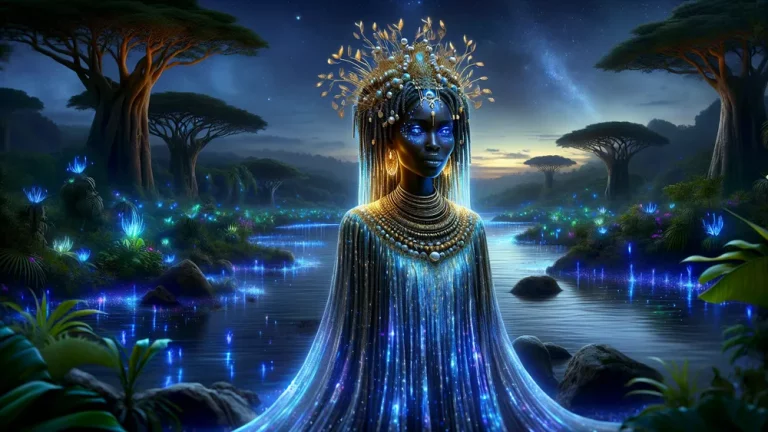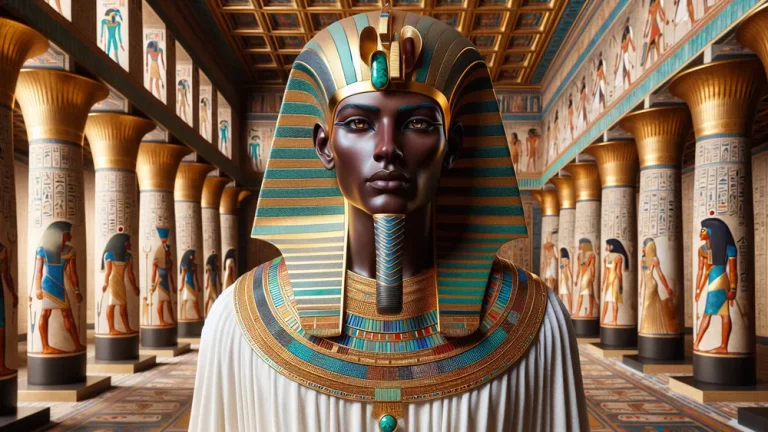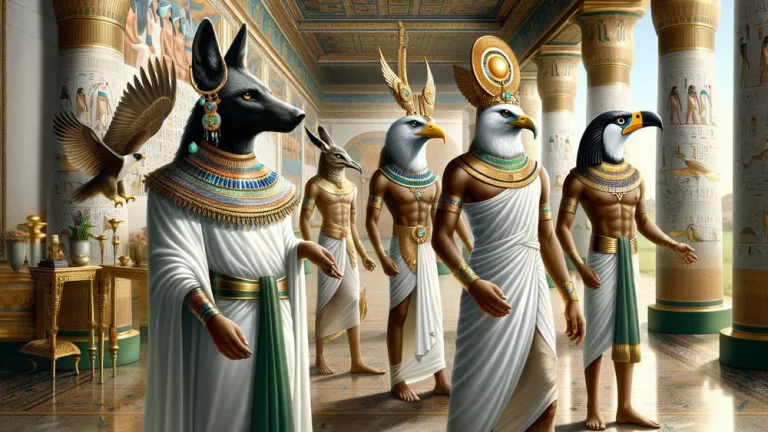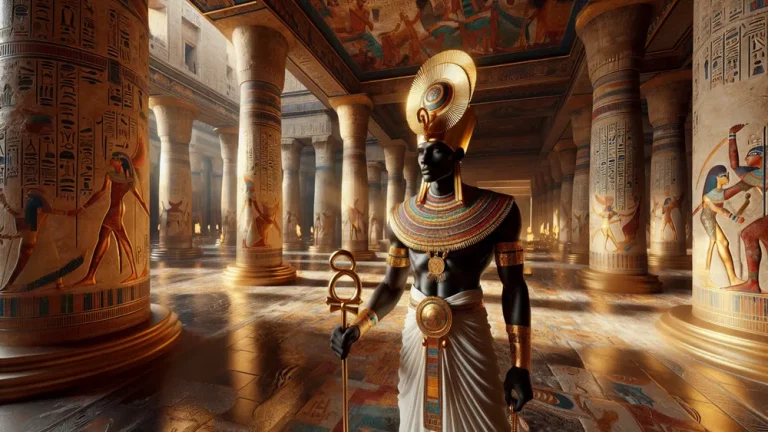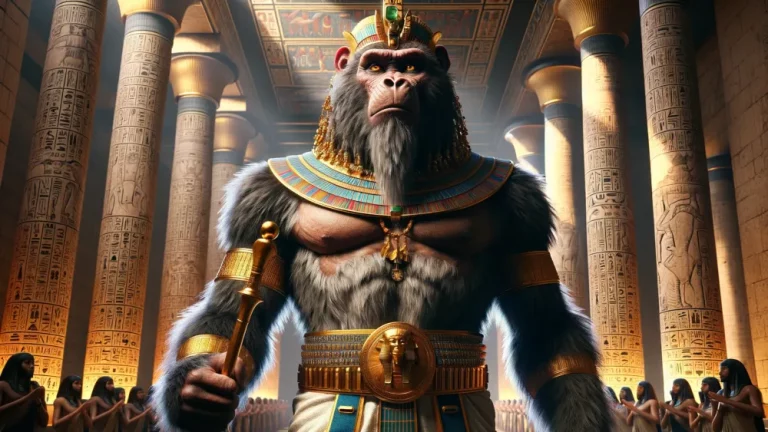Nilus: Greek God Of The Nile River And Son Of Oceanus
Greek mythology, with its gods, heroes, and places, is a big set of ideas that always fits together with nature and the universe. Some of the gods, like Zeus, Poseidon, and Athena, are names people hear all the time. However, other gods, like Nilus, are hard to fully understand but still matter a lot.
Key Points:
- Nilus is a Greek river god linked to the Nile and is the son of Oceanus and Tethys.
- He represents life, farming, and growth, tying Greek and Egyptian worlds together through mythology.
- His children include Memphis, tied to the founding of the Egyptian city, and Chione, symbolizing cold water or snow.
- Nilus is one of the Potamioi, river gods representing rivers, who are sons of Oceanus and Tethys.
- The Nile River, which Nilus represents, was essential for Egyptian civilization, symbolizing fertility and survival.
- Greek traditions connect him to rituals of water gods, while Egyptians associate him with Hapy, their god of the Nile’s floods.
- Nilus is linked to myths of city origins, like Memphis, and stories about life rebounding after floods.
Nilus, who people link to the Nile River in Egypt, is one of these quieter gods. He doesn’t make as much noise in mythology, but his role is big, because to the Greeks, rivers acted as gods while also being just what they physically were. The Nile River, for instance, wasn’t just a body of water – it meant survival for people.
It impacted their lands and lives completely. This article talks about Nilus as someone who holds meaning in myths. First, he comes from Oceanus and Tethys, who are called his parents. Then, the role he takes up with other river gods (known as Potamioi) tells you why he matters.
Finally, his stories and how he shows up in myths give us ideas about him. You can find out how Nilus allows us to see an idea that mixes both Greek and Egyptian worlds.
For those who know mythology or even those who don’t, learning about Nilus stands for a way to think about what ancient people thought about rivers, land, and gods.
Nilus: Overview and Key Facts
| Aspect | Details |
|---|---|
| Name | Nilus (Νεῖλος in Greek), a Greek mythological god of rivers. |
| Realm | The Nile River, an important river in the ancient world. It is mostly linked to Egypt. |
| Parentage | He is the son of Oceanus and Tethys, who are Titans that represent water. |
| Siblings | One of the Potamioi (river gods), sharing family ties with all rivers and nymphs like Styx, Metis, and Doris. |
| Symbolism | Stands for how water is tied to life, farming, and growth, showing the Nile’s role in making civilizations thrive. |
| Children | Includes Memphis (tied to the Egyptian city of Memphis) and Chione (linked to snow or cold water), along with others. |
| Unique Position | Different from most Greek river gods, since Nilus connects Greek myths to Egypt, meaning the influence of Greece spreads far. |
| Wider Significance | Seen as a connection between Greek myths and Egyptian beliefs, which highlights how old cultures interacted. |
| Mythological Role | A character who isn’t very famous in myths but still appears in family trees, river tales, and ideas about unity between places and gods. |
| Cultural Representation | Often thought about in stories tied to city beginnings (like Memphis) or the Nile’s importance in keeping life possible. |
Where Nilus Comes From and His Family Roots
To understand where Nilus fits in Greek mythology, you need to look at his family and who his parents were. He connects to the early, basic powers in nature. This helps explain how he became part of such a large group of gods tied to rivers and water. Let’s find out about his parents and see how he fits with all the other river gods.
Who is Nilus in Greek Mythology?
Nilus is a god from Greek mythology who represented the Nile River, which played a major role in ancient times. He didn’t gain much fame compared to other gods, but he stood for the water, farming, and life the Nile provided. This river wasn’t just important in Egypt; it was vital for ancient civilizations around it as well.
Nilus, according to Greek stories, was the son of Oceanus and Tethys, two Titans linked to water. Because of this, he belonged to the group of river gods called the Potamioi, who represented rivers across different lands. Unlike most of his siblings, whose rivers were tied to places in or near Greece, Nilus was linked to a river far from Greece.
This connection made his role special because it joined Greek myths with Egyptian stories. His position as the god of the Nile highlighted how rivers could stand for both physical and divine things – linking people, gods, and the land.
- Key Aspects of Nilus in Greek Mythology:
- Realm: The Nile River, which was needed for farming, trade, and everyday life.
- Parentage: Born to Oceanus and Tethys, gods of water.
- Symbolism: Life, growth, and farming tied to the Nile.
- Role: A Potamios (river god) that connected Greek and Egyptian myths.
- Wider Significance: Stood for the divine role of rivers, especially the Nile.
Nilus was a Greek river god of the Nile, symbolizing life, farming, and the connection between Greek and Egyptian myths.
Meet Oceanus and Tethys: Nilus’s Parents
In Greek mythology, Oceanus and Tethys are two of the twelve original Titans. They are the children of Uranus (Sky) and Gaia (Earth) and represent the forces behind water everywhere. Oceanus is seen as the god of the wide ocean, which the ancient Greeks thought of as a massive stream that surrounded the world they knew.
They imagined it as the edge of everything, marking the border between their lands and the unknown. Unlike other Titans, Oceanus stayed calm and didn’t take an active role in the Titanomachy, the war between the Titans and Olympians. He didn’t fight Zeus or the Olympians, which made him different.
Some saw him as a peaceful figure, suited to his role as the god of the world’s biggest body of water. He is also considered the father of all rivers, seas, and water systems, putting him at the center of everything tied to water in the world. Tethys, who is both Oceanus’s sister and wife, plays a similar role but focuses on fresh water.
Her care extends to rivers, but also smaller sources like springs and fountains, as well as underground water. She is said to be the mother of all the Potamioi (river gods, such as Nilus) and the Oceanids (the nymphs of smaller water bodies). Because of her many children, she is often seen as a provider who helps life and growth.
Even though there aren’t many myths directly about her, she is important in the system of water gods. Together, Oceanus and Tethys form a pair that represents how water continuously moves and supports nature. Many gods, like Nilus, come from this family and carry out their roles across the Earth.
The Kids of Nilus
Nilus, who is a symbol of the Nile River, had several children who became important in both Greek and Egyptian mythology. One of his famous daughters is Memphis. Her name is tied to the ancient Egyptian city with the same name. In myths about gods and their families, Memphis marries Epaphus, who is the son of both Zeus and Io.
Through her life, Memphis becomes more than just a figure linked to the Nile. She plays a big role in myths about how Egyptian society began, including the start of the city of Memphis. Her story means the children of Nilus often connect gods to the creation of real, important places. Another child of Nilus is Chione.
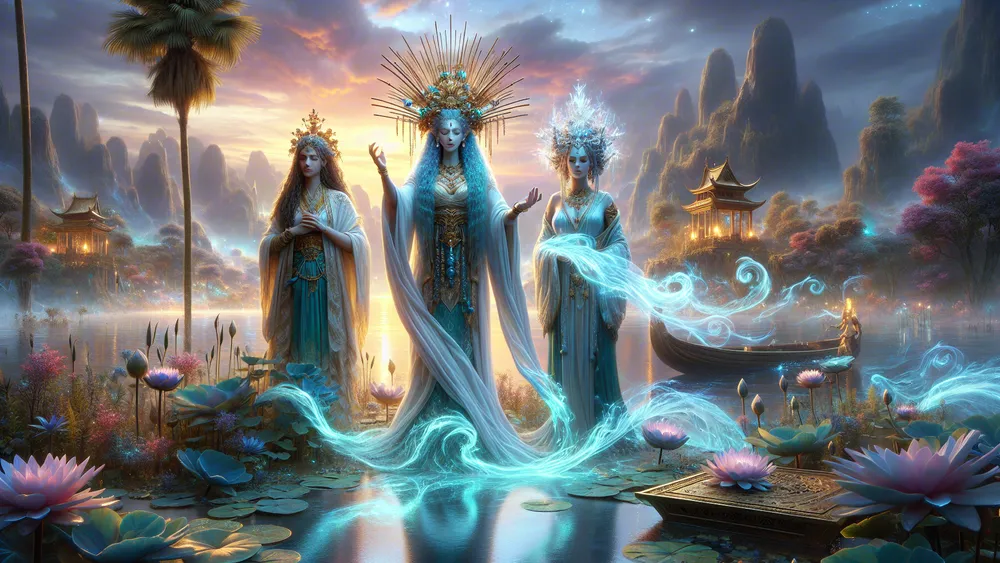
Her name means “snow” in Greek and suggests some link to things like colder rivers or other natural features tied to water. In some versions of her story, she is seen as a symbol of snow and the colder side of nature, though different accounts give her varying roles. Myths that mention Chione often connect her to rivers or other ideas about the power of water.
Through his children, the legacy of Nilus spreads to different areas and ideas. It shows both the helpful and harmful forces connected to rivers and nature.
- Key Children and Their Roles:
- Memphis: Wife of Epaphus and connected to ancient stories about the city of Memphis in Egypt.
- Chione: A symbol of snow or colder rivers, representing the different types of water found in nature.
- Other children: Less detailed in myths but often tied to rivers, springs, and other water sources connected to Nilus’s domain.
Nilus and the River Gods (the Potamioi)
Nilus is part of the group of river gods known as the Potamioi. These gods, all sons of Oceanus and Tethys, stand for rivers, with each one tied to a vital waterway. Most of the Potamioi, like Achelous in Greece or Styx, represent rivers connected to Greek places or myths. But Nilus is different.
He is the god of the Nile River, and the Nile, more than almost any other river, played a central role in keeping Egyptian society going. This link made Nilus more than just a Greek river god. It connected him to something much bigger than Greece. The Nile gave life to an entire civilization. It helped grow food, supported villages, and let cities thrive.
Because of this, Nilus was tied to the ideas of fertility, growth, and the ability of water to sustain people. Like his siblings in the Potamioi, these were the ideas he stood for. But since he was the god of the Nile River, he wasn’t just important to myths about Greece – his role went beyond that, connected to one of the most important rivers in all of world history.
Through this role, he reminds us that rivers were seen as not only natural features but also as holy paths that gave life to the world.
What Nilus Symbolized and Why He Mattered
As one of the Potamioi and the symbol of the Nile River, Nilus had a role that went beyond his own myths. He wasn’t just a river god in stories – he stood for bigger ideas. His role mattered because it pointed to things like life, fertility, and how ancient societies depended on rivers to survive.
Through his connection to the Nile River, Nilus became a way for people to think about ideas that shaped their world. This river wasn’t just important; it was essential to the way life worked in Egypt and even influenced people far away. All of this meant that Nilus represented much more than his place in mythology alone.
Nilus as the Living Spirit of the Nile River
In Greek myths, Nilus was not just a river god. He was the sacred representation of the Nile River, which was one of the most important waterways in history. For the Greeks, the Nile meant much more than just being a big river. It was how Egyptian society lived.
The Nile gave water to farmers, helped grow plants, and acted as a key route for trade and for people to interact with each other. In myths, Nilus was called the “living spirit” of the Nile. This title meant that his connection to the river was tied to its ability to keep life going.
He was thought of as a constant source of fertility and growth, which were necessary for life. The Nile, through him, was seen as something holy. It mattered to everything – the people, the animals, and the land. Ancient people respected natural forces like this, turning rivers into holy symbols that they believed deserved to be praised. Through Nilus, the Nile River wasn’t just a place on a map.
It was a living thing that gave life to everything around it.
How Nilus Was Worshipped in Greece and Beyond
The way Nilus was respected shows how the idea of honoring river gods wasn’t limited to one place. It connected many cultures. In Greek traditions, Nilus was mostly viewed as part of the group called the Potamioi, the river gods. These gods stood for things like energy in nature, fertility, and the endless cycles of life.
While there isn’t much evidence to tell us how people worshipped Nilus directly in Greece, he was linked to the larger network of water gods like Oceanus and Tethys, and rituals for them often included items such as fruits, flowers, and other symbols of richness as a way to say thanks for the life rivers provided.
In Greek art, Nilus was sometimes shown as a person holding objects like a cornucopia, which means he was thought of as someone who provided food and abundance. In Egypt, though, Nilus became more important because he was connected to Hapy, the god who represented the Nile’s flooding. For Egyptians, the Nile was at the center of survival, and its yearly floods kept their farms alive.
Festivals were held every year for this. People threw bread, fruits, and other items in the water as offerings to honor it. Hymns and prayers were also made to praise the power behind the Nile’s floods, which included Nilus as a symbol of life always continuing. These practices didn’t just mean that people cared about water.
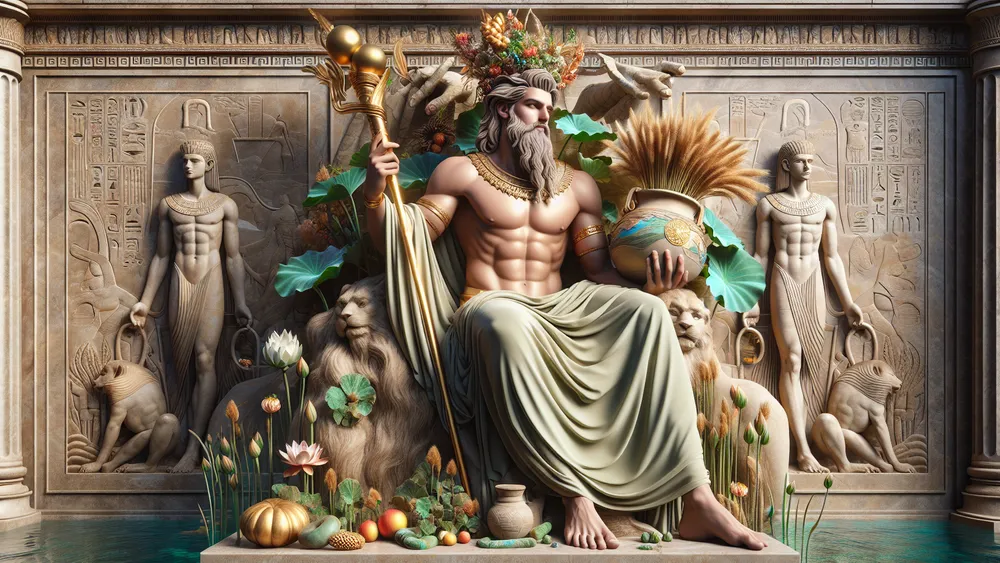
They also show how ideas from Greek and Egyptian religions came together, tied to how important the Nile was for both everyday life and religion.
| Aspect of Worship | Greek Practices | Egyptian Practices |
|---|---|---|
| Focus | Respect for all rivers, with Nilus part of the Potamioi group. | Special attention to the Nile’s floods, tied directly to how people survived. |
| Offerings | Fruits, flowers, and other simple items to thank river gods. | Bread, fruits, and other important objects were thrown into the Nile during flood celebrations. |
| Artistic Depictions | Nilus shown with symbols like the cornucopia, representing abundance. | The Nile was linked to Hapy and shown in religious art, which Greeks connected to Nilus. |
| Rituals | Generic ceremonies for rivers, often as part of larger Greek traditions. | Specific festivals and hymns focused on the Nile’s flooding and how it gave life to their lands. |
Nilus was a symbol of life and abundance in both Greek and Egyptian traditions, connecting their beliefs through shared respect for rivers and the essential role of the Nile’s floods.
Nilus and Hapy: Tying Greek and Egyptian Myths Together
Nilus and Hapy explain how Greek and Egyptian myths sometimes came together to describe the same natural events in their own ways. In Greek mythology, Nilus was a river god, part of the group known as the Potamioi, and he stood for the Nile River as something that made life and fertility possible. In Egyptian mythology, Hapy had a very specific role.
He was the god of the Nile’s yearly floods, which were extremely important for keeping farms and people alive. Even though both were connected to the Nile, they were seen differently. In Greece, Nilus was linked to larger ideas about how water gave life to the world.
He was a part of their bigger system of river gods and even tied to Oceanus, their idea of a god connected to all rivers. Meanwhile, Hapy in Egypt was shown as a bearded man with a large belly. He held plants like papyrus and lotus, which stood for the things the floods brought to people.
These two figures are connected because of the Nile River, something the Greeks saw as a holy part of Egypt, but they still described it differently based on their beliefs. This link between Nilus and Hapy reminds us that people in ancient times often shared their respect for things like water and nature, even if their own traditions were different.
It also means both cultures found ways to make natural events important in their myths.
Nilus in Ancient Art and Stories
In ancient Greek art, Nilus was usually seen as a strong, older man. He stood for the Nile River and the way it made life and growth possible. Like other river gods, Nilus was often shown lying down in a calm position. Around him, there were objects like water jars or cornucopias filled with fruits and grain, things that stood for abundance and plenty. Sometimes, crocodiles or lotus flowers were added to the images.
These objects represented traits unique to the Nile. Occasionally, parts of Egyptian symbolism were included in the art, showing how Greek and Egyptian ideas about the Nile could combine in subtle ways. Although Nilus was not talked about as much in Greek stories, he still appeared in myths that traced the family lines of important people like Memphis or Chione.
In those stories, he was shown as both an ancestor and someone who represented the life the Nile River gave to the world. These images and stories worked together, acting as a reminder of how central the Nile was. Its role was not just about nature; it was also part of how people thought about the gods and their order in the world.
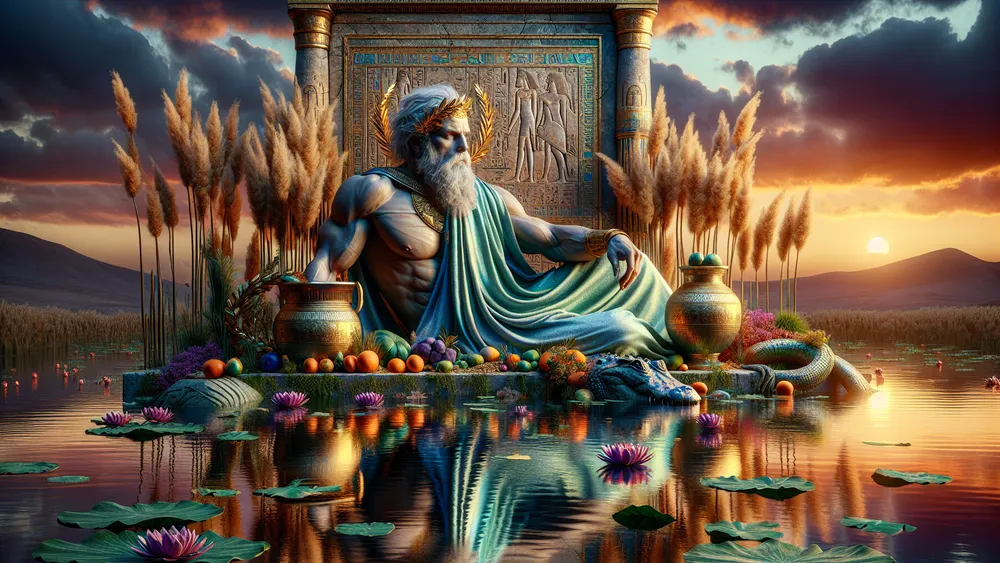
This is how Nilus stayed important in both art and myths for a long time.
Stories and Myths About Nilus
The importance of Nilus goes beyond what he stood for and the respect people gave him. It also includes the interesting myths and family-related stories that were about him. We can explore the parts of these stories where Nilus had a role in shaping the old accounts and leaving his mark on the stories of the past.
Memphis, Nilus’s Daughter: A Story of Love and Founding Cities
In Greek mythology, Memphis is known as the daughter of Nilus, the river god. She is often described as a woman of beauty and importance in old stories about families. Like many river gods, Nilus passed his power to descendants who carried ideas tied to life, success, and fertility.
Memphis’s importance comes particularly from her marriage to Epaphus, a mortal son of Zeus and Io, which connected her river background to his divine one. Together, they symbolized a link between gods and human rulers, an idea often used to explain the start of civilizations or royal families. Their story is an example of how gods and mortals were connected in myths.
Epaphus, the ruler of Egypt, married Memphis, creating a bond that represented both nature, through Memphis and her connection to the river, and human kingship, through Epaphus. Through her, Nilus’s legacy spread across Egypt, tying together natural forces, gods, and human rulers. This connection also showed how important the Nile was for giving life and supporting Egyptian civilization. The most remembered part of Memphis’s story is the city named after her.
Some accounts say that the capital of Egypt, Memphis, was named to honor her. The city, built in a key spot near the Nile, highlighted the connection between Memphis, her river background, and Nilus. It also mixed Greek myths with Egyptian traditions, making Memphis a symbol of unity between gods, geography, and people.

Nilus’s Role in the Big Flood Myth
In Greek mythology, stories about floods often stand for a god’s answer to problems with people or a way to start life over again. As a river god, Nilus fits into this bigger idea.
While stories of big floods, like the one about Deucalion and Pyrrha, usually say that Zeus caused them, smaller stories suggest that river gods like Nilus had an important part after the disaster. Like other Potamioi (river gods), Nilus is tied to flowing water and is part of stories about how life comes back because of nature’s gifts.
Even though floods destroy, they are also needed to bring fertile ground back, especially in Egyptian myth where the Nile River was essential. For this reason, Nilus stands for both the danger of too much water and its ability to bring life again. This represents the two sides of nature that are often tied to gods.
One myth talks about Nilus helping life recover after a major flood. Zeus sends down the floodwaters to destroy the earth, but Nilus appears as someone who reduces the damage. He makes sure the flood doesn’t last too long and that the Nile River’s waters return to bring fertile ground back for farming.
These stories closely match the actual role of the Nile River in Egyptian life, where its yearly flooding was risky but very important for supporting people. In these myths, Nilus takes care of survivors by helping them find good land or by keeping some part of life safe through how he connects to the river’s patterns.
These small but important stories mean we see Nilus as both a helper after destruction and a symbol of the balance between chaos and recovery, a key idea in flood myths.
Nilus, as a river god, represents the balance between destruction and renewal in myths, often helping life recover after devastating floods by ensuring the Nile’s life-giving waters return.
When Heracles Met Nilus
An interesting event in Greek mythology is the meeting between Heracles, known for his strength and his many adventures, and Nilus, the god of the Nile River. While the specific details of how they met are not always clear, some stories say it happened during the time Heracles traveled through Egypt.
In these accounts, Nilus, as the god connected to the river, might have had a role in helping or testing Heracles while he dealt with the challenges of the land and its rivers. Nilus is sometimes described as a figure tied to water and life, appearing both as a person in myths and as a way to represent the river itself.
Whether he guided or stood in the hero’s way, his role reflects the way nature and gods were connected in the trials of Heracles. Stories like this match a larger pattern in myths about Heracles, where he meets gods tied to specific places, such as mountains, rivers, or other natural landmarks, combining his human efforts with the powers of nature.
Although what Nilus’s exact part was may not always be fully explained in every version of the tale, the meeting between the two still points to the way mythological heroes often moved through lands shaped by divine forces.
These events remind us that the actions of heroes like Heracles were not just about personal achievement but were also closely tied to the powerful elements of nature, like rivers and landscapes, and the gods connected to them.
Nilus and the Beginning of Cities and Nations
In Greek mythology, Nilus is seen as a vital ancestor in family lines that link gods to the creation of cities and societies. As a figure tied to the Nile River, his children – Memphis and Chione – helped shape the growth of important regions connected to this key water source.
For example, Memphis, his daughter, is known for her role in the founding of the city of Memphis in Egypt. This city later became one of the most important cultural and economic centers in ancient history.
Similarly, Chione, another child of Nilus, is linked to myths about fertility and abundance, showing how Nilus’s descendants represented the river’s power to support life and prosperity. These connections explain, through myths, how great cities and societies started, using family relations to give divine meaning to human settlements.
More than just cities, Nilus and his children represent a significant idea in mythology: the connection between natural resources and the beginning of human organization. Rivers like the Nile River were not only physical lifelines but also symbols of agriculture, trade, and progress.
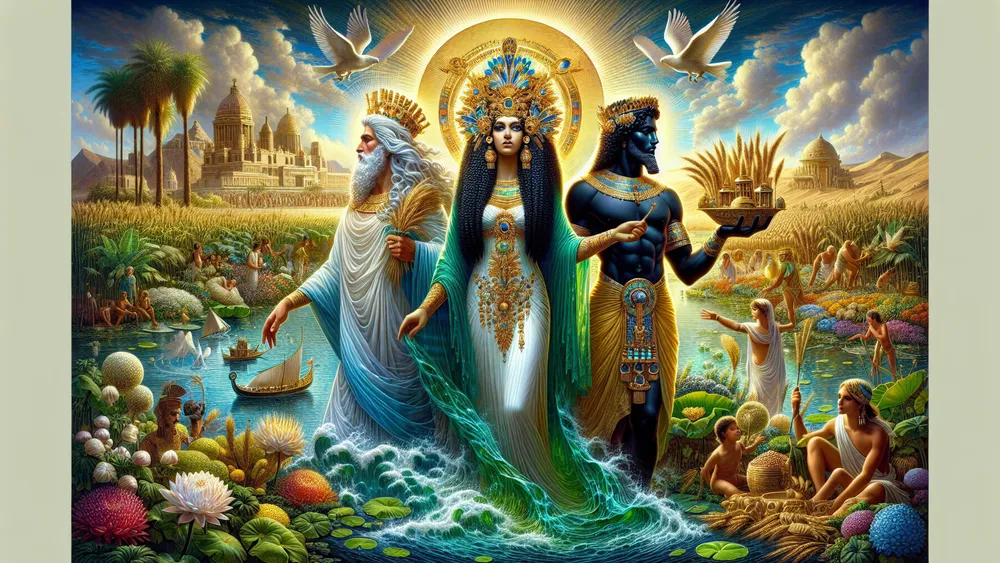
By giving Nilus children who were seen as founders or leaders, the myths point out how central rivers were to both the physical and cultural success of early civilizations. This way of thinking, where rivers like Nilus are described as heavenly ancestors, reflects how real rivers became the centers of early human growth.
These stories about Nilus and his family show the lasting truth that the success of any city or nation depends on the waters that give it life.
Geography in Greek Myths
Geography is very important in Greek mythology, where rivers, mountains, and other parts of the land were seen as alive, sometimes even spirits or gods. For example, the river god Nilus and Mount Olympus, where the gods are said to live, mean we can see how the Greeks thought about their land. They believed that real places were part of their myths.
Famous events happened in places like the Labyrinth of Crete or the Trojan plain, putting stories of gods and heroes into locations people could recognize. These stories say something about how Greeks connected to their world – they made their myths match what they saw around them, describing nature as both powerful and full of meaning.
Rivers, cities, mountains, and seas were more than just parts of the natural world. The Greeks, through their myths, tied them to the actions of gods and mortals. If you want to understand how these places mattered to their stories, you can find a complete list of Greek geographical concepts in this Greek Geographical Concepts list.
It covers all the mountains, rivers, and other landmarks found in the myths.
FAQs
1. Who were the parents of Nilus in Greek mythology?
The parents of Nilus in Greek mythology were Oceanus and Tethys.
2. How was Nilus worshipped in ancient times?
How Nilus was worshipped in ancient times involved rituals centered around offerings to honor the Nile’s life-giving and fertile powers, particularly during the flooding season.
3. Are there connections between Nilus and the Egyptian god of the Nile?
Connections between Nilus and the Egyptian god of the Nile, Hapy, exist through their shared association with the river’s life-giving and fertile qualities, reflecting intercultural influences between Greek and Egyptian mythologies.
4. What myths involve Nilus’s descendants?
Myths involving Nilus’s descendants often center on figures like his daughter Memphis, who is linked to the founding of the city of Memphis, and his lineage, which plays a role in genealogical ties to ancient cities and peoples.


